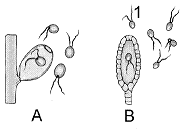In what way do segregational petite mutations differ from neutral petites?
A) Neutral petites are dominant and segregational petites are recessive mitochondrial genes.
B) Segregational petites follow Mendelian inheritance as a result of the influence of nuclear genes; neutral petites, when crossed to wild type, produce only wild-type, normal-sized colonies.
C) When a neutral petite is crossed to a segregational petite, all offspring are neutral petites.
D) When a segregational petite is crossed to a wild-type cell, all offspring are petite. However, when a neutral petite is crossed to a wild-type cell, all offspring are wild type.
E) Neutral petites follow Mendelian inheritance as a result of the influence of nuclear genes; segregational petites, when crossed to wild type, produce only wild-type, normal-sized colonies.
Answer: B
You might also like to view...
A soft drink manufacturer, notorious for making marketing claims that are deceptive but technically accurate, has released a new sports beverage. The advertisements for this beverage assert that it contains three grams of chlorophyll per bottle, which will give the user extra energy during exercise performed in direct sunlight. Naturally, you buy a bottle to test its ingredients, and you are able to verify that it does, in fact, contain three grams of plant-sourced chlorophyll. Have you finally caught the company in a lie?
a. Yes! Three grams of chlorophyll is insufficient to produce measurable amounts of energy. b. No; chlorophyll in leafy greens and sports drinks continues photosynthesis after ingestion. c. Yes! Sunlight will have no effect on the amount of energy derived from digested chlorophyll. d. Yes! Humans cannot metabolize the carbohydrates produced by photosynthesis.
Pyrosomes are gelatinous zooplankton composed of a colony of individual pelagic tunicates
Indicate whether the statement is true or false
Which example shows nonevolutionary change in a population?
A) an increase in mosquitoes that are resistant to insecticide B) plants in a dry climate that have faster-growing roots than plants found there 20 years ago C) after decreases in airborne soot, a change in the most common color of moths D) an increase in the number of people diagnosed with colon cancer
What is the structure labeled as 1 in the accompanying figure?

a. heterospore
b. homospore
c. embryo
d. gamete
e. zygote